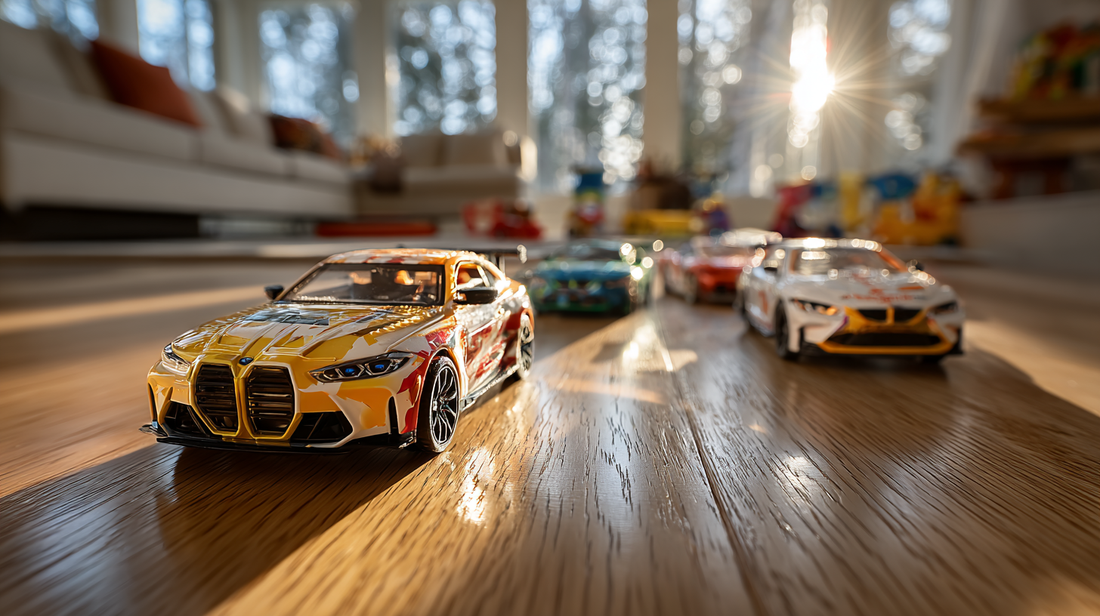
Why Micro RC Cars Are the Perfect Hobby for Small Spaces
Share
Micro RC cars offer an exhilarating hobby for enthusiasts with limited space, transforming tabletops, living rooms, or small apartments into thrilling race tracks. These compact vehicles, typically 1/24 to 1/64 scale, combine precision engineering with affordability and ease of use, making them ideal for urban dwellers or beginners. From drift cars like the WLtoys 284131 to detailed replicas like the Kyosho MA-020 Mini-Z Subaru WRX STI, micro RC cars deliver big fun in small packages. This article explores why micro RC cars are perfect for confined spaces, highlighting their compact design, cost-effectiveness, versatility, and vibrant community, helping you kickstart your hobby with RCModelsHub.
Compact Size for Any Space
Micro RC cars, ranging from 2 to 8 inches, are designed for tight spaces where larger models (1/10 scale) are impractical. Models like the HPI Nano-TTR Mustang RTR-X (1/64 scale, 2.8 inches) fit on a coffee table, while the WLtoys 284131 (1/28 scale, 6 inches) races smoothly on kitchen tiles or carpet. Their small footprint eliminates the need for large outdoor areas, making them ideal for apartments, dorms, or offices. Storage is effortless—most cars fit in a drawer or display case, doubling as collectibles. This compact size allows hobbyists to enjoy racing or drifting without sacrificing space, perfect for urban lifestyles.
Affordable Entry to the RC Hobby
Micro RC cars are budget-friendly, with prices ranging from $20 to $150, compared to $200–$500 for larger models like short course trucks. Entry-level options, such as the JoyfulHao 1/43 Drift Car, cost as little as $30, including batteries and chargers, lowering the barrier for beginners. Mid-range models like the Kyosho MA-020 Mini-Z ($100–$150) offer advanced features like AWD and upgradeable chassis without breaking the bank. Accessories, such as extra batteries ($10–$20) or drift tires ($5–$15), are also affordable, allowing hobbyists to customize without significant investment. This cost-effectiveness makes micro RC cars an accessible hobby for all ages and budgets.
Easy to Use for Beginners
Micro RC cars are forgiving for newcomers, with simpler controls and lower speeds (5–20 mph) than larger brushless models (40+ mph). Ready-to-run (RTR) kits like the WLtoys 284131 include everything needed—car, transmitter, battery, and charger—requiring no assembly. Features like adjustable throttle settings (e.g., 20%, 50%, 100% on the JoyfulHao Drift Car) help beginners master steering and drifting. Micro cars’ lightweight design (20–100g) reduces crash damage, and durable ABS or polycarbonate bodies withstand minor impacts. Their 2.4GHz transmitters ensure precise control in small spaces, making them ideal for learning the ropes before tackling larger RC vehicles.
Versatile Performance and Customization
Despite their size, micro RC cars offer diverse performance suited to indoor environments. Drift cars like the Kyosho MA-020 Mini-Z excel on slick surfaces with AWD and drift tires, while touring cars like the HPI Nano-TTR Mustang prioritize grip for racing. Indoor tracks can be crafted with household items—tape, books, or mats—creating custom circuits for drifting or time trials. Many models support upgrades, such as gyro units for the WLtoys 284131 to enhance stability or LED kits for nighttime aesthetics. This versatility allows hobbyists to tailor their cars for racing, drifting, or display, keeping the hobby engaging in small spaces.
Vibrant Community and Competitive Fun
Micro RC cars foster a thriving community, connecting hobbyists through local clubs, online forums, and indoor race events. Platforms like Reddit’s r/rccars or Mini-Z forums share setup tips, track designs, and upgrade guides. Local hobby shops often host micro drift meets, where cars like the Kyosho MA-020 shine in competitive formats. These events are accessible in urban areas, requiring minimal space compared to outdoor races. Online tutorials from channels like RC Driver demonstrate techniques for models like the HPI Nano-TTR, helping beginners improve skills. This community engagement adds a social dimension, making micro RC cars a rewarding hobby.
Practical Considerations for Small Spaces
Micro RC cars require minimal setup and maintenance, ideal for busy urban lifestyles. Most models, like the JoyfulHao Drift Car, charge via USB in 30–40 minutes, offering 15–20 minutes of runtime. Maintenance is straightforward—clean with a soft brush, check batteries, and tighten screws every 5–10 runs. Indoor surfaces (tile, carpet, wood) are sufficient, but mats or drift boards enhance performance for cars like the WLtoys 284131. Safety is simple: avoid fragile objects, supervise young users (14+ recommended), and follow battery charging guidelines. These practical benefits ensure micro RC cars fit seamlessly into small living spaces.
Getting Started with Micro RC Cars
Starting your micro RC hobby is easy with RCModelsHub. Recommended models include:
- WLtoys 284131 1/28 Drift Car ($50–$80): Affordable, with LED lights and three batteries for indoor drifting.
- Kyosho MA-020 Mini-Z Subaru WRX STI ($100–$150): AWD and upgradeable for serious drifters.
- HPI Nano-TTR Mustang RTR-X ($50–$80): Ultra-micro with functional LEDs, ideal for collectors.
Budget $20–$50 for accessories like extra batteries or tools. Check manuals for setup, join online communities, and experiment with indoor tracks to maximize fun.
Why Choose Micro RC Cars?
Micro RC cars are the ultimate hobby for small spaces, offering compact size, affordability, ease of use, and versatile performance. Whether drifting with the Kyosho MA-020 or racing the HPI Nano-TTR, these cars bring excitement to any room. Their low cost and minimal maintenance make them accessible, while community events add competitive thrill. Explore RCModelsHub for top micro RC cars and start your indoor racing adventure today!
